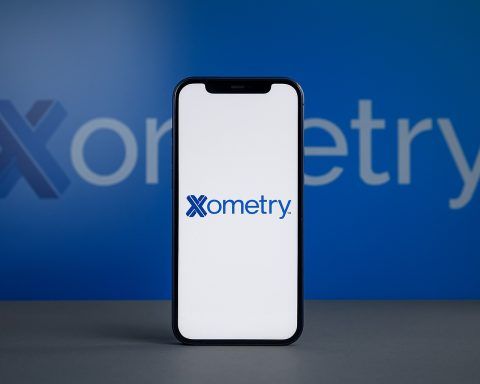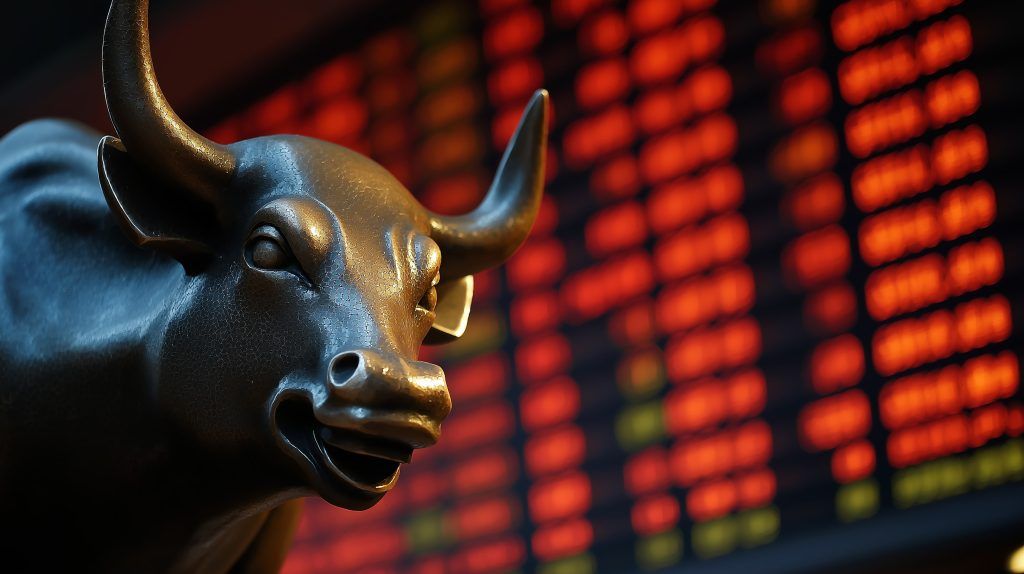- Stock Surge & Slip: Grab’s stock has climbed over 40% in the past year, far outpacing rivals like GoTo [1]. It is up about 28% year-to-date 2025 [2] and notched a 25% gain in the last 3 months [3]. However, shares plunged ~9% on Nov 4, 2025 after the latest earnings, falling from ~$6.07 to the mid-$5 range [4] [5].
- Q3 Earnings Beat:Revenue hit $873 million in Q3 2025 (▲22% YoY), topping estimates [6]. Grab eked out a $17 million profit, up from $15 M a year ago [7], and adjusted EBITDA jumped 51% to $136 M [8] – marking its 15th consecutive quarterly EBITDA improvement.
- Raised Forecasts: On strong momentum, Grab raised its 2025 outlook – now guiding $3.38–$3.40 billion in revenue (up from $3.33–$3.40 B) and $490–$500 M in adj. EBITDA (up from $460–$480 M) [9] [10]. Management’s confidence reflects robust demand and cost discipline.
- User & Segment Growth: Grab’s monthly users hit 47.7 million (▲14% YoY) [11]. Food delivery revenue jumped 23% to $465 M, boosted by higher gross merchandise value and ad sales [12]. Mobility (ride-hailing) grew 17% to $317 M [13], while financial services revenue leapt 39% (to $90 M) as Grab’s digital lending expanded [14].
- Analyst Outlook: Wall Street is “cautiously optimistic” – the consensus rating is Moderate Buy (1.8/5) with an average price target ~$6.40 [15], suggesting upside. Analysts foresee earnings more than doubling in 2025 (from $0.05 to $0.11 EPS) [16] thanks to Grab’s improving profitability.
- Strategic Moves: Grab continues evolving as a one-stop “superapp” – integrating ride-hailing, food delivery, groceries, and fintech services [17]. It’s attracting cost-conscious users with cheaper ride and delivery options, then upselling ~40% of them to premium services [18]. The company is also investing in autonomous vehicles – partnering with U.S. startup May Mobility and China’s WeRide – to bring robotaxis to Southeast Asia [19] [20].
- Competitive Edge: In Southeast Asia, Grab faces rivals like Indonesia’s GoTo (Gojek-Tokopedia) and Thailand’s Line Man. Grab has launched aggressive discounts to win market share from competitors like GoTo [21], and reportedly even held merger talks with GoTo [22]. So far, Grab’s stock has outperformed GoTo’s [23], reflecting its dominant hold on ride-share and food delivery (which make up ~89% of revenue) [24]. Another regional peer, Sea Ltd, competes in digital payments and e-commerce; all three firms (Grab, Sea, GoTo) are racing to grow their fintech and digital finance businesses [25]. Notably, Uber is a major Grab shareholder (after Grab acquired Uber’s SE Asia operations) – Grab is often dubbed “the Uber of Southeast Asia” [26].
Stock Price & Recent Performance
Grab’s logo displayed on a smartphone screen, symbolizing its mobile “superapp” platform bridging ride-hailing, food delivery, and financial services. As of November 4, 2025, Grab Holdings’ stock trades around $5.5 per share after a post-earnings pullback. The shares tumbled ~9.2% in the wake of Q3 results [27], retreating from a $6.07 closing price before the announcement [28]. Despite this one-day drop, Grab’s stock has been on a strong uptrend in 2025. It has gained roughly +28% year-to-date [29] and is up over 40% versus a year ago, handily outperforming regional rival GoTo [30]. In fact, over the latest quarter alone, GRAB shares climbed ~25% [31] amid rising investor optimism.
This year’s rally reflects improving sentiment as Grab edges toward profitability. However, the steep post-earnings selloff shows that investors had lofty expectations – the stock’s sharp drop came even though Grab beat revenue forecasts and raised guidance. The market reaction suggests some traders were disappointed by the modest net profit or chose to take profits after the recent run-up. Overall, Grab’s stock remains well below its initial SPAC listing price (around $10 in 2021), but its 2025 rebound indicates growing confidence in the company’s long-term trajectory.
Q3 2025 Earnings: Strong Growth with a Modest Profit
Grab’s third-quarter 2025 earnings, reported on Nov 3, showcased robust growth across key metrics. Revenue jumped 22% year-over-year to $873 million, slightly above analyst expectations (est. ~$871 M) [32]. This top-line growth was driven by higher usage of Grab’s on-demand services even amid an “uncertain economy.” The company’s On-Demand GMV (gross merchandise value) – the total value of ride and delivery transactions – surged 24% YoY to $5.8 billion [33], a sign that more consumers are using Grab for their daily needs.
Crucially, Grab inched into the black again with a quarterly profit of $17 million. This was only a $2 M improvement from the $15 M profit a year ago [34], underscoring that net income is still slim. The small profit fell short of some investor hopes, prompting the stock drop. Nonetheless, profitability metrics are trending up: Adjusted EBITDA (earnings before interest, tax, depreciation, amortization) came in at $136 million, up 51% from a year prior [35]. This marks Grab’s 15th consecutive quarter of EBITDA growth, reflecting disciplined cost control and improving unit economics.
Cash flow is also improving. Grab generated $203 M in adjusted free cash flow in Q3 and about $283 M over the past 12 months, signaling that its business is not only growing but also self-funding [36]. “This quarter marks another vital step forward in our journey, not just in financial performance, but in how we are building a more resilient, technology-driven platform for the long term,” said CEO Anthony Tan in the earnings release, highlighting the focus on sustainable growth [37].
Segment performance was solid across the board:
- Deliveries (Food & Grocery): Revenue rose to $465 million (▲23% YoY) as people continued ordering food and essentials via Grab’s platform [38]. Growth was fueled by a 24% surge in deliveries GMV and higher advertising revenue from merchants on the app [39]. The company noted improving delivery segment margins, helped by scale and ad monetization – COO Alex Hungate pointed out that delivery profit margins are expanding and should continue to grow into next year even as Grab invests in new services [40].
- Mobility (Ride-Hailing): Grab’s mobility business – ride-hailing and transport – continued its post-pandemic rebound. Revenue climbed 17% to $317 million [41], with mobility GMV topping $2.0 B. Rides demand has stayed resilient despite higher fuel costs, and Grab has been adding driver-partners; the company noted a “healthy increase in partners joining our gig platform to earn income,” which in turn reduces customer wait times [42].
- Financial Services: This newer segment (digital payments, lending, fintech) was a standout, albeit from a small base. Revenue jumped 39% to $90 million [43]. Grab’s loan book grew 65% YoY to $821 M [44] as it expands digital lending and insurance offerings. The fintech push is helping diversify Grab’s revenue – though it currently contributes under 15% of sales, it’s the fastest-growing area. Importantly, losses in fintech are narrowing as the business scales.
- User Growth: Grab’s ecosystem kept expanding, reaching 47.7 million monthly transacting users (MTUs) in Q3, up from 41.9 M a year ago [45]. More users are transacting more frequently – on average, GMV per user rose ~7% YoY [46] – indicating higher spending per customer as Grab upsells additional services.
In sum, Grab’s Q3 results painted a picture of a high-growth platform edging toward profitability. Revenues and gross bookings are rising at a double-digit pace, and Grab is managing to eke out small profits while heavily reinvesting in expansion. However, the market clearly wanted to see stronger earnings leverage. The slight profit beat (just $17 M) left some underwhelmed, given Grab’s rich valuation. This dynamic – rapid growth vs. thin profit – sets the stage for the company’s next moves.
Raised Guidance and 2025 Outlook
Armed with its Q3 results, Grab raised its full-year 2025 guidance, signaling confidence in continued growth. The company now expects FY2025 revenue of $3.38–$3.40 billion, tightening the range upward from a prior $3.33–$3.40 B [47]. It also hiked its adjusted EBITDA forecast to $490–$500 M (from $460–$480 M) [48]. In other words, Grab is lifting the low end of both revenue and profit forecasts, effectively projecting a stronger finish to the year.
Management’s tone was optimistic. “We continued to accelerate growth while delivering sequential EBITDA margin improvements… This quarter’s results underscore the resilience of our model,” said CFO Peter Oey, noting Grab’s ability to grow even in a challenging macro environment [49] [50]. The company highlighted that cost controls and scale efficiencies are kicking in, allowing for better margins even as it chases expansion. For example, Grab’s regional corporate costs grew only modestly (to $95 M) despite much higher revenue [51], reflecting tighter overhead management.
Looking ahead, Grab’s leaders remain bullish on growth opportunities. They plan to “invest in new product initiatives” – such as groceries and fintech – but in a disciplined way that preserves margin gains [52]. Notably, Grab is stepping up its financial services expansion (digital banking, lending, wealth management) to supplement its core ride and delivery revenue. In Q3’s call, execs highlighted a 65% YoY jump in the loan portfolio and strong demand for Buy Now, Pay Later offerings [53]. These fintech ventures, while still small, could become significant profit centers if they achieve scale.
Wall Street analysts appear to validate Grab’s rosy outlook. Consensus estimates for 2025 predict a sharp jump in earnings, with EPS expected to grow ~120% (from $0.05 in 2024 to $0.11 in 2025 on average) [54]. That reflects expectations that Grab will move decisively past break-even and start delivering meaningful profits. The average analyst price target of ~$6.40 for GRAB stock [55]implies belief that shares have room to run higher, given current prices around $5–$6. “Analyst sentiment remains cautiously optimistic,” notes GuruFocus, with a 1.8 (Moderate Buy) rating consensus and multiple firms highlighting Grab’s improving fundamentals [56].
At the same time, some analysts urge caution due to lofty valuation multiples. Even after the recent dip, Grab trades at a high revenue multiple (around 8× price/sales), suggesting the stock prices in a lot of future growth [57]. Any missteps – e.g. a slowdown in growth or spike in cash burn – could spur volatility. This may explain the market’s reaction to Q3: investors wanted an even bigger profit beat or shareholder returns (like a buyback) given the stock’s strong run. One trader quipped that “If they announce a buyback, game over for shorts”, underlining the pent-up bullishness in some retail circles [58].
Speaking of retail sentiment, Grab has caught fire on social media investing forums. After the earnings release and guidance raise, retail chatter on Stocktwits turned “extremely bullish” (from neutral), and message volumes spiked over +1,400% in 24 hours [59]. Many individual investors are enthusiastic about Grab’s long-term potential as the dominant Southeast Asian tech platform – often comparing it to early-stage Uber or Alibaba. This optimism from the retail crowd provides added fuel (and volatility) to GRAB shares, though it remains to be seen if fundamentals can ultimately justify the hype.
Strategic Initiatives and Business Updates
Beyond the headline numbers, Grab’s recent moves underscore its ambition to be the go-to superapp for Southeast Asia’s digital economy. The company continues to diversify and innovate across its businesses, which has strategic implications for its competitive positioning. Here are some key updates and initiatives:
- Superapp Expansion: Grab’s strategy is to make its app a one-stop shop for consumers’ everyday needs. Already, users can hail rides, order food, grocery shop (GrabMart), pay bills, buy insurance, and even do banking – all within Grab’s ecosystem. This quarter, Grab noted that its superapp approach is gaining “strong traction” as consumers seek convenience [60]. Multi-service users tend to be more engaged and valuable. Grab’s data shows higher cross-usage; for instance, someone attracted by a cheap ride might later use GrabFood or GrabPay, increasing their lifetime value.
- Affordable Offerings to Drive Growth: In 2023–25, Grab rolled out “Saver” options – lower-cost tiers for rides and deliveries (e.g. carpooling, GrabFood Value meals). This has been a deliberate play to capture price-sensitive users during a period of economic uncertainty. The payoff is evident: about one-third of new users now enter via these affordable channels, and roughly 40% of them eventually upgrade to standard (higher-margin) services [61]. By hooking cost-conscious customers with discounts, Grab is expanding its user base while upselling them over time. This tactic also helps Grab defend against competitors on price. The CFO highlighted that these budget offerings provide a “buffer against spending downturns”, making Grab more resilient if consumer wallets tighten [62].
- Incentives and Market Share: Grab hasn’t shied away from promotions in its battle for market share. The company introduced aggressive incentive programs and discounts in key markets – for example, rewarding frequent eaters or giving ride vouchers – to pull users away from rivals like GoTo [63]. While incentives weighed on short-term margins (total incentives were $585 M in Q3) [64], Grab kept them fairly stable as a percentage of GMV (~10%) by improving efficiency. This strategy appears to be paying off: Grab has either maintained or grown its #1 market position in mobility and food delivery across most of Southeast Asia. Its superapp now has the highest engagement in the region, according to management, and merchants increasingly view Grab as an essential sales channel (boosting Grab’s advertising and fintech revenues).
- Autonomous Vehicles (AV) Push: A headline recent development is Grab’s foray into autonomous driving technology. In October 2025, Grab announced a strategic partnership and investment in May Mobility, a U.S.-based robotaxi startup [65] [66]. This deal will see May Mobility’s self-driving software integrated into Grab’s platform – leveraging Grab’s ride-hailing fleet management and GrabMaps for routing [67]. It’s May Mobility’s third partnership (after Lyft and Uber in the U.S.), and signals Grab’s intent to lead the robotaxi rollout in Southeast Asia. “The deal is a step toward commercial deployment of robotaxis… creating a blueprint for how self-driving taxis are managed within existing ride-hailing platforms,” Reuters noted [68]. Separately, Grab is already working with WeRide, a Chinese autonomous driving firm. In September, Grab was selected by a Singapore district to pilot autonomous shuttles, partnering with WeRide to deploy driverless vehicles on select routes by early next year [69]. Grab’s approach to AV is partnership-driven – invest in or ally with tech players rather than develop it all in-house – and management emphasized a “hybrid fleet” vision where human drivers and AVs coexist for the foreseeable future [70]. These moves could give Grab a first-mover edge in AV services regionally, addressing driver shortages and operating costs in the long run. Notably, Uber (a Grab investor) is pursuing a similar AV strategy in its markets, so Grab’s initiatives may help it keep pace with global peers on innovation.
- Fintech and Digital Banking: Grab’s financial services arm (GrabFin) is another strategic focus. Along with partner Singtel, Grab launched digital banks in Singapore and Malaysia in 2022, and it’s expanding fintech offerings like wallet payments, micro-investments, insurance, and loans across its user base. The 39% YoY revenue jump in financial services this quarter shows early traction [71]. In particular, Grab’s lending business (offering working capital to drivers/merchants and pay-later loans to consumers) is scaling fast – the loan book grew to $821 M [72]. While this growth is promising, the company remains cautious on credit risk, especially as macro conditions fluctuate. Grab has kept loan default rates manageable so far and often partners with banks or uses third-party capital for lending to limit balance sheet risk. Fintech is a crowded space with the likes of SeaMoney (Sea Ltd) and traditional banks, but Grab is betting its huge user base and data can give it an edge in underwriting and distribution.
- Advertising & Other Services: An unsung growth area is GrabAds, the advertising unit. Grab has started monetizing the high engagement on its app by allowing restaurants, consumer brands, and even drivers to advertise to Grab’s millions of users. The company noted that ad revenues contributed to the Deliveries segment growth this quarter [73]. As a superapp with rich data on consumer behavior, Grab has a viable ads business (similar to how Amazon leverages e-commerce data for ads). This high-margin revenue stream could bolster profitability further. Additionally, Grab is exploring new services like hotel bookings and ticketing (GrabTravel), and enterprise offerings via GrabForBusiness, to increase customer wallet share.
Competitive Landscape: Grab vs. Gojek, Sea & Uber
Grab operates in a fiercely competitive arena, squaring off against both regional and global players. Here’s how it stacks up against some key rivals:
- GoTo (Gojek Tokopedia): In Indonesia – Southeast Asia’s biggest market – Grab’s main competitor is GoTo, formed from the 2021 merger of ride-hail giant Gojek and e-commerce firm Tokopedia. GoTo mirrors Grab’s superapp model, offering rides, deliveries, shopping and fintech to Indonesians. Competition between Grab and Gojek (now GoTo) has been intense for years, especially in ride-hailing and food delivery. Grab has managed to maintain a leading position in Indonesia’s mobility market, while GoTo leads in e-commerce. Both are expanding into each other’s turf (Grab into grocery and shopping, GoTo into on-demand services). Notably, reports surfaced that Grab and GoTo have held preliminary talks about a possible merger or partnership [74]. Such a merger would create a Southeast Asian tech behemoth, but it faces regulatory and shareholder hurdles. For now, Grab is focused on outcompeting GoTo organically – for example, by using promotions to lure Gojek’s drivers and riders. Grab’s superior financial position (over $5 billion cash on hand) and multi-country presence give it some leverage. Indeed, Grab’s stock has significantly outperformed GoTo’s since GoTo’s IPO [75], reflecting investor belief that Grab has a stronger path to profitability. Still, Indonesia remains a critical battleground: success there is crucial for both companies’ fortunes.
- Sea Limited (Shopee/Food):Sea Ltd (NYSE: SE) is another Southeast Asian tech titan, known for its Shopee e-commerce platform and Garena gaming arm. While Sea’s core is e-commerce, it has been foraying into food delivery (ShopeeFood) and digital payments (ShopeePay) – encroaching on Grab’s territory. Sea, Grab, and GoTo are increasingly overlapping in services, and all three have been boosting their fintech units as a growth driver [76]. Sea’s ShopeeFood operates in markets like Indonesia and Malaysia, directly challenging GrabFood with aggressive discounts funded by Sea’s past profits from gaming. However, Sea has faced its own challenges (widening losses in e-commerce in 2022–2023), and recently shifted towards efficiency and profitability, much like Grab. Grab’s edge against Sea is its entrenched ride-hailing network and the breadth of its superapp. Grab continues to dominate the region’s mobility and food delivery segments – areas where Sea is a newer entrant [77]. On the flip side, Sea has a massive user base from e-commerce that it can cross-sell services to, plus deep pockets (previously fueled by gaming cash flows). For investors, Grab and Sea offer different exposures to Southeast Asia’s growth: Grab is a purer play on urban mobility and local services, whereas Sea spans e-commerce, entertainment, and payments. Both are pushing into digital banking and lending. It’s worth noting that Sea’s market cap is substantially larger (over $30 B) and it has global investors’ attention; Grab will need flawless execution to prevent Sea from eroding its market share in deliveries or digital finance.
- Uber and Other Global Players:Uber Technologies – the global ride-hailing leader – is not a direct competitor in Southeast Asia anymore; in fact, Uber is a major shareholder in Grab after selling Uber’s SE Asian operations to Grab in 2018. Uber took a ~27.5% stake in Grab as part of that deal [78]. This means Uber’s interests are aligned with Grab’s success in the region. Nonetheless, Uber’s presence looms in the background as a benchmark. Grab is often dubbed “the Uber of Southeast Asia,” and it models parts of its strategy on Uber’s playbook (for instance, expanding into deliveries and exploring autonomous cars). In other domains, Grab faces potential competition from the likes of Didi (China) if it ever expands outward, and from smaller local startups in certain niches (for example, Foodpanda in food delivery, or AirAsia Ride in Malaysia). Thus far, Grab has managed to fend off rivals by continuous innovation and heavy investment – and sometimes by consolidation (it acquired Uber’s business and earlier bought smaller rivals in Vietnam and Thailand). Its focus on being a homegrown regional champion is a selling point in Southeast Asia’s diverse markets, where understanding local preferences and governments is key. Grab also emphasizes compliance with local regulations (e.g. working closely with authorities on new services like autonomous shuttles) to maintain goodwill and avoid regulatory setbacks.
In summary, Grab’s competitive moat lies in its scale and ecosystem. With operations in eight countries and services spanning transport, food, payments, and more, Grab has built a network effect that is tough to replicate. It leads in market share for ride-hailing and food delivery in multiple Southeast Asian countries [79], giving it a large user base to monetize. Its closest competitor, GoTo, is strong in Indonesia but has less presence elsewhere. Sea is formidable in e-commerce but still ramping up in Grab’s arenas. Execution and focus will be key – Grab is striving to be profitable while expanding, a balance that will determine if it stays ahead of the pack.
Conclusion
As of November 2025, Grab Holdings Limited stands at a pivotal moment. The company has proven it can grow rapidly and even turn a profit in consecutive quarters – a milestone for Southeast Asia’s tech scene. Its Q3 2025 earnings beat and raised forecasts underscore improving fundamentals: double-digit revenue growth, expanding EBITDA, and an accelerating superapp ecosystem. These strengths have fueled a big run in GRAB’s stock (up ~40% in a year), yet the recent post-earnings stock dip shows that investors are watching profit margins and execution closely.
Going forward, Grab’s narrative is one of high-growth optimism tempered by profitability discipline. The public markets are expecting Grab to follow through on its promise of sustainable earnings – not just growth at any cost. The next few quarters will be telling. If Grab can continue boosting margins (as its COO predicts) while still growing services and beating back competition, the stock’s uptrend could resume. Analysts remain largely positive, citing Grab’s market leadership and improved cost control as reasons it could be undervalued relative to its long-term potential [80] [81].
However, challenges persist: competition isn’t sitting still, global economic winds could shift consumer spending, and tech investor sentiment can be fickle. For now, Grab’s management is signaling confidence by raising guidance and investing in innovation. The company is betting on new frontiers – from robotaxis to digital banking – to drive the next leg of growth. If those bets pay off, Grab could solidify its status as the dominant “do-everything” app of Southeast Asia, delivering value to users and shareholders alike. In the meantime, the “Uber of Southeast Asia” is a stock to watch, as it navigates the path from breakneck growth toward a more mature, profitable future.
Sources:
- Reuters – Grab beats quarterly revenue estimates on resilient consumer spending [82] [83] [84]
- Reuters – Grab invests in May Mobility as robotaxi startup expands to Southeast Asia [85] [86]
- Stocktwits News – Grab Stock Sees Surge In Retail Buzz After Raising Earnings Forecast [87] [88] [89]
- Investing.com – Grab shares tumble as Q3 profit falls short despite revenue beat [90] [91] [92]
- GuruFocus – Grab (GRAB) Reports Strong Q3 Growth with $5.8 Billion GMV [93] [94] [95]
- Simply Wall St – Grab Holdings: 25% Share Price Gain and Valuation [96] [97]
- MarketBeat – Grab Q3 2025 Earnings and Estimates [98] [99]
- TipRanks – Grab’s Q3 2025 Earnings Show Strong Growth and Strategic Expansion [100] [101]
- Bloomberg – Grab Raises Outlook… (via Bing snippet) [102]
References
1. www.bloomberg.com, 2. stocktwits.com, 3. simplywall.st, 4. www.investing.com, 5. www.marketbeat.com, 6. www.investing.com, 7. www.investing.com, 8. www.gurufocus.com, 9. www.reuters.com, 10. www.reuters.com, 11. stocktwits.com, 12. stocktwits.com, 13. stocktwits.com, 14. www.investing.com, 15. www.gurufocus.com, 16. www.marketbeat.com, 17. www.reuters.com, 18. www.reuters.com, 19. www.reuters.com, 20. www.tipranks.com, 21. stocktwits.com, 22. stocktwits.com, 23. www.bloomberg.com, 24. www.gurufocus.com, 25. fortune.com, 26. stocktwits.com, 27. www.investing.com, 28. www.marketbeat.com, 29. stocktwits.com, 30. www.bloomberg.com, 31. simplywall.st, 32. www.investing.com, 33. www.gurufocus.com, 34. www.investing.com, 35. www.gurufocus.com, 36. www.gurufocus.com, 37. www.investing.com, 38. stocktwits.com, 39. stocktwits.com, 40. stocktwits.com, 41. stocktwits.com, 42. stocktwits.com, 43. www.investing.com, 44. www.marketscreener.com, 45. stocktwits.com, 46. www.marketscreener.com, 47. www.reuters.com, 48. www.reuters.com, 49. www.marketscreener.com, 50. www.marketscreener.com, 51. www.marketscreener.com, 52. stocktwits.com, 53. www.marketscreener.com, 54. www.marketbeat.com, 55. www.gurufocus.com, 56. www.gurufocus.com, 57. simplywall.st, 58. stocktwits.com, 59. stocktwits.com, 60. www.reuters.com, 61. www.reuters.com, 62. www.reuters.com, 63. stocktwits.com, 64. www.marketscreener.com, 65. www.reuters.com, 66. www.reuters.com, 67. www.reuters.com, 68. www.reuters.com, 69. www.reuters.com, 70. gabgrowth.com, 71. www.investing.com, 72. www.marketscreener.com, 73. stocktwits.com, 74. stocktwits.com, 75. www.bloomberg.com, 76. fortune.com, 77. www.fool.com, 78. stocktwits.com, 79. www.gurufocus.com, 80. simplywall.st, 81. simplywall.st, 82. www.reuters.com, 83. www.reuters.com, 84. www.reuters.com, 85. www.reuters.com, 86. www.reuters.com, 87. stocktwits.com, 88. stocktwits.com, 89. stocktwits.com, 90. www.investing.com, 91. www.investing.com, 92. www.investing.com, 93. www.gurufocus.com, 94. www.gurufocus.com, 95. www.gurufocus.com, 96. simplywall.st, 97. simplywall.st, 98. www.marketbeat.com, 99. www.marketbeat.com, 100. www.tipranks.com, 101. www.tipranks.com, 102. www.bloomberg.com












